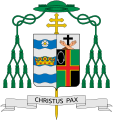English: Coat of arms of the U.S. Archbishop James Patterson Lyke, Archbishop of Atlanta (1991-1992).
The entire "achievement," or coat of arms as it is generally called, is composed of the shield with its charges, the motto and the external ornaments. As one looks at the shield the terms dexter (right) and sinister (left) must be understood contrariwise, as the shield was worn on the arm in medieval days and these terms were used in the relationship of the one bearing the shield.
The dexter impalement is given in ecclesiastical heraldry to the arms of jurisdiction; in this instance, the arms of the Archdiocese of Atlanta.
Atlanta known as the "Crossroads of the South," because of converging railroads which gave the city its early prominence, received its name as the eastern terminus of the Western and Atlantic Railroad which connected north Georgia with the Tennessee River. Originally called Whitehall, then Terminus, and afterwards in 1843 Marthasville, the state legislature finally acquiesced to the wishes of the railroad and accepted the name of Atlanta in 1847, thus naming the city indirectly after the Atlantic Ocean.
The Atlantic Ocean is represented on the shield of the archdiocese by white and blue wavy bars, the heraldic equivalent of the waves of the sea; seven bars in number to symbolize the Seven Sacraments.
The crown of Christ the King denotes the title of the cathedral church, the Eternal King whose redeeming Sacrifice on the Cross is renewed daily in the Holy Sacrifice of the Mass. Above the crown is placed the Cherokee rose, the State flower of Georgia (Rosa Laevigata), as befits an archdiocese located in the Capital City. The Cherokee rose is a white flower with a yellow center.
The crown of Christ the King, in the arms of the Archdiocese of Atlanta, also has the secondary representation of the crown of King George II of England after whom Georgia was named. The blue and white wavy bands may be said as well to symbolize the rolling foothills of the Blue Ridge country; but, more important, these are the colors of our Blessed Mother.
The sinister impalement, on the right of the viewer, bears the personal arms of Archbishop Lyke. These consist of a quartered shield on the lower two-thirds of the sinister in black and green with a gold cross. Superimposed on this is a narrower red cross. The colors red, black and green are significant to black Americans because they were used by the Universal Negro Improvement Association and African Communities League. They are dominant in the flags of many African nations. Red symbolizes redemption, blood and liberty; black is for the black people and green stands for the motherland, Africa.
The quartered shield with the gold cross recalls the mystery of the Church and honors Pope John Paul II from whose coat of arms it is derived. The narrower cross imposed on the gold cross is red, the academic color for theology and conveys Archbishop Lyke's special interest in same.
In the first quadrant of the quartered shield is a white chaplet of the Franciscan cord to emphasize Archbishop Lyke's devotion to Saint Francis of Assisi and the Franciscan ideal.
The upper portion of the shield displays the arms of the Friars Minor. The field is silver (white) with a black Latin cross above two crossed arms. One arm wears a Franciscan robe representing Saint Francis. It is pierced, recalling that the saint was a stigmatic. The other arm with pierced hand represents the crucified Christ.
The Latin motto "Christus Pax," translates as "Christ Our Peace," and is taken from Saint Paul's epistle to the Ephesians, chapter 2, verses 13 and 14. The motto further emphasizes the cross of Christ which reconciles our differences and unites all in faith.
Behind the arms is placed a gold archiepiscopal cross with double traverse. Surrounding the shield or "achievement," is a pontifical hat with ten tassels on each side in four rows, all in green
Prior to 1870, the pontifical hat was worn in solemn conclaves held in conjunction with papal functions. The color of the pontifical hat and the number and color of the tassels were signs of the rank of a prelate, a custom which is still preserved in ecclesiastical heraldry.
Reference:

